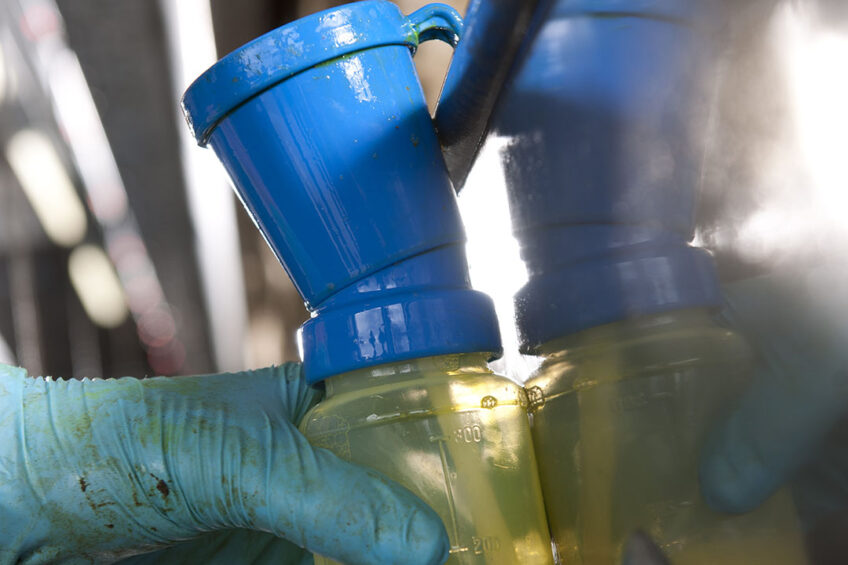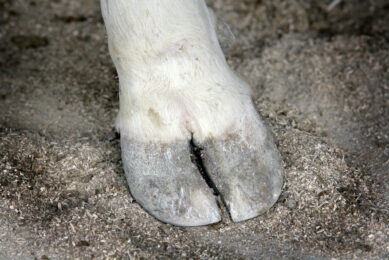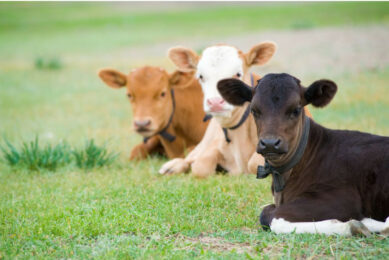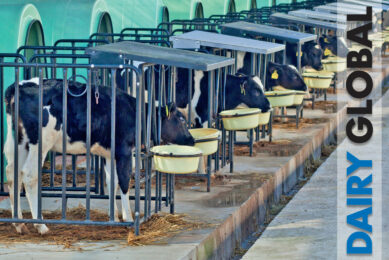Mycoplasma bovis mastitis: Prevention is crucial

Treatment for Mycoplasma bovis-caused mastitis is disappointing at best. Prevention is key.
Mycoplasma bovis continues to make headlines around the world, especially in New Zealand where officials continue efforts to eradicate the bovine pathogen through widespread culling. M. bovis causes a range of clinical presentations but M. bovis mastitis is particularly disastrous because successful treatment options are extremely limited. For this reason, prevention is crucial. Dr Colin Mason, a veterinarian with SRUC Veterinary Services in the UK, spoke on the subject at the British Mastitis Conference, which took place in Worcester in November 2019.
In large outbreaks, cows will be culled and will die, there will be a significant impact in terms of cell count, and a significant impact in terms of clinical mastitis,” – Dr Colin Mason
First recognised as a bovine pathogen in 1961, Mycoplasma bovis was first discovered in the UK in the mid-1970s, and more recently in New Zealand in 2017. In UK dairy herds, M. bovis most commonly causes pneumonia, arthritis and keratoconjunctivitis, among other diseases. Less commonly, M. bovis causes mastitis. In fact, Dr Mason estimates that mastitis diagnoses are about one-tenth of pneumonia diagnoses in the UK. Note that this is not a statistically significant sample.

“It might be that if you went and surveyed, you might get a different answer, but I don’t think it will change that much,” he said.
Regardless, since mastitis treatment is ineffective and outbreaks often end in significant herd loss, its mere mention raises alarm bells.
Outbreaks can be quite devastating, said Dr Mason. When they do occur, they generally come in the form of pneumonia, arthritis and mastitis together. On an individual farm, when outbreaks do occur they can be nasty and costly.
“In large outbreaks, cows will be culled and will die, there will be a significant impact in terms of cell count, and a significant impact in terms of clinical mastitis,” he said. “We do get these large outbreaks periodically, but frankly, they’re not that common.”
Also read: Image labelling to detect mastitis in cows
Transmission and treatment
 |
| Hygiene is of utmost importance, the use of gloves and post-milking teat disinfection is recommended. Photo: Mark Pasveer |
Mycoplasma bovis is transmitted in a number of ways. It can be transferred via direct udder and teat contact through the milking machine. It can also be transmitted via direct contact, which means hands and tools pose a risk if they are not properly disinfected.
Another means of spread is airborne transmission, which increases risk significantly in large and expanding herds, especially where cows are in close contact with one another.
According to diagnostic research, some of the organism’s characteristics directly impact antibiotic treatment choices. Due to cell structure and because the organism does not synthesise folic acid, some antibiotics are completely ineffective. Some of the antibiotics that do control M. bovis are considered High Priority Critically Important Antibiotics (HPCIAs), which poses obvious challenges. Even more concerning, a 2014 study comparing antibiotic sensitivity for M. bovis isolates suggests resistance could be developing.
Prevention strategies
While there is not a lot of evidence-based information related to the transmission of M. bovis in the UK, Dr Mason said there is enough available evidence to provide practical control measures. Control, biosecurity and prevention are the key elements of it from a mastitis point of view.
It’s impossible for you to know for sure if you’re buying cattle that are free from Mycoplasma bovis,” – Dr Mason.
Preventing infected cows entering the herd
His first recommendation is to stop infected cows from entering the herd. Since new stock does not come with a bill of health, the onus is very much on the buyer, said Dr Mason.
While it is possible to buy disease-free cattle for some infectious diseases, such as BVD and IBR, information on M. bovis is not available at the point of sale just yet. This means that it is risky to introduce new livestock to the herd.
“It’s impossible for you to know for sure if you’re buying cattle that are free from Mycoplasma bovis,” said Dr Mason.
Currently, researchers don’t even know how many herds are infected in the UK at the moment. “We suspect it’s quite a high number,” Dr Mason added. “But we actually don’t know what the number is.”
- Screening:
One way to reduce risk is to screen cows before they enter the herd. The easiest way to screen cows for mastitis-causing M. bovis is to screen their milk upon arrival, said Dr Mason. To further minimise risk, he suggests milking them last, at least until results come back negative. - Providing separate space:
Providing separate space to reduce the risk of spread is another good method of control, although this could prove challenging for some farmers. - Disease pathways:
Finally, if it is suspected that M. bovis is the cause of mastitis on the farm, it is important to think about possible pathways for the disease’s spread. The first might seem obvious, but it’s sometimes overlooked. “With the exception of colostrum, don’t feed your milk to calves,” he said. “Because all you’re doing is then setting up a new round of infection.”
Also read: New ‘cure’ to tackle mastitis
Control the spread of M. bovis
If M. bovis is already present in the herd, the following controls can be used to prevent the spread of disease. Since the disease can be spread via direct contact, milking hygiene is of the utmost importance. Dr Mason promotes the use of single-use towels, gloves and post-milking teat disinfection.
In a 2002 study, 5 different teat dip classes were tested for efficacy against 3 bovine M. bovis species. It was shown that M. bovis was susceptible to commercial test disinfectants that contained 1% hydrogen peroxide, 1% chlorine dioxide, and 0.5%-1% Iodofor solutions. Dr Mason notes, though, that these tests were conducted in experimental models only and may not translate well in field conditions in all cases. Regardless, teat disinfection is proven to be an excellent method for controlling the spread of disease.
Milking plant wash cycles should also be reviewed and improved where necessary.
Culling as a form of control
While there are some reports of animals self-curing, it’s not common. Generally speaking, M. bovis-caused mastitis is not readily treatable.
“Ultimately, these animals need to be considered on their merits, but a lot of them will end up being culled,” said Dr Mason.
Although culling is a recognised strategy to control disease spread, herd-wide culling is not necessary.
New Zealand has presented an intriguing case for mass culling only because the pathogen is so new to the island that eradication and therefore a return to zero status, experts believe, is possible.
“They’re in a situation still where the disease is not endemic,” he said. “It’s a low-prevalence situation, and they’ve got a chance of kicking it out.”
But a lot of countries are not in that situation, so that cannot be compared. Eradication in the UK, for example, wouldn’t be possible without wiping out a proportion of the national herd.
Going forward, knowing herd status could play an important role in curbing the spread of M. bovis. Negative status herds, said Dr Mason, could be used for replacements. Better quality vaccines could play an important role going forward as well.
Join 13,000+ subscribers
Subscribe to our newsletter to stay updated about all the need-to-know content in the dairy sector, two times a week.










